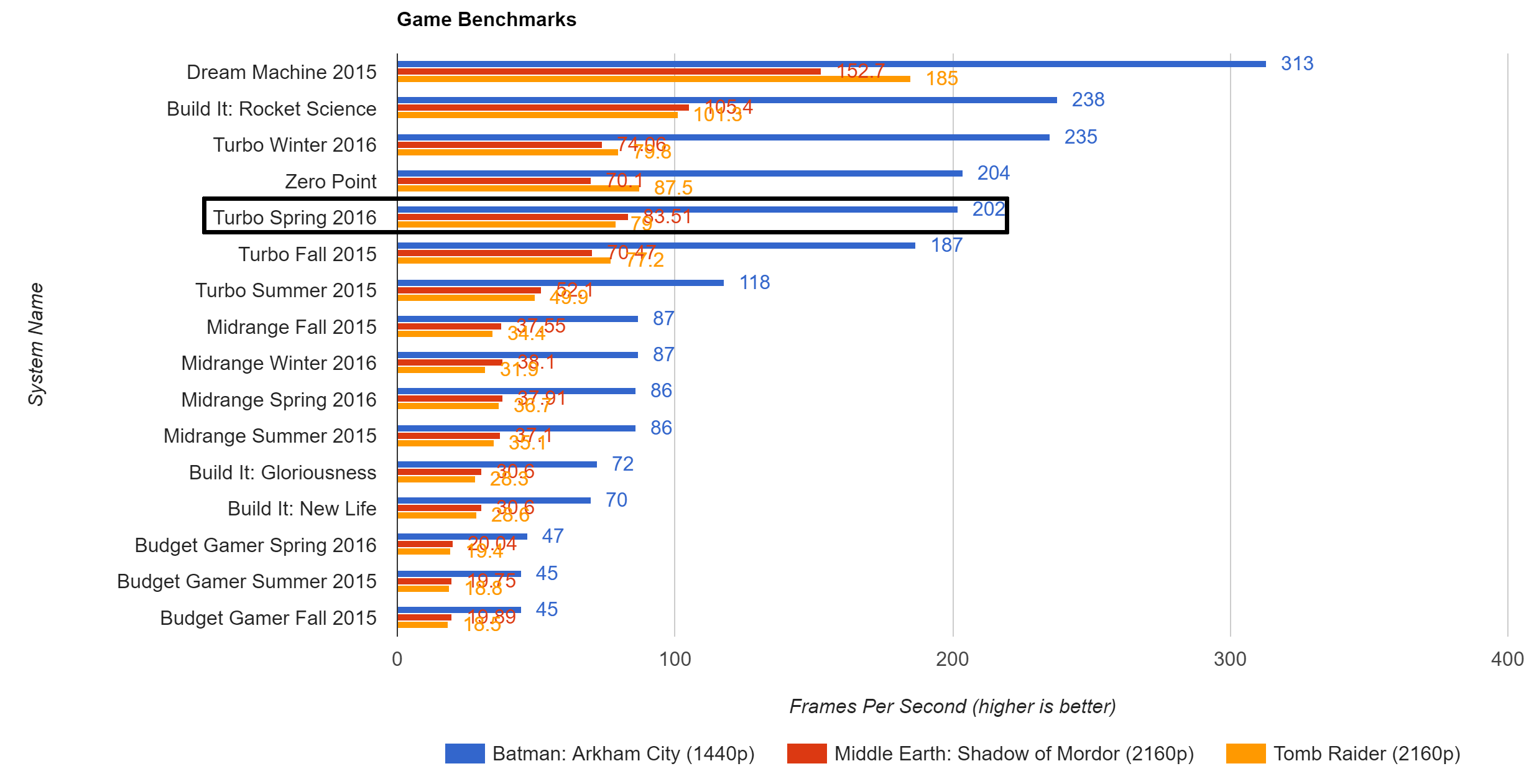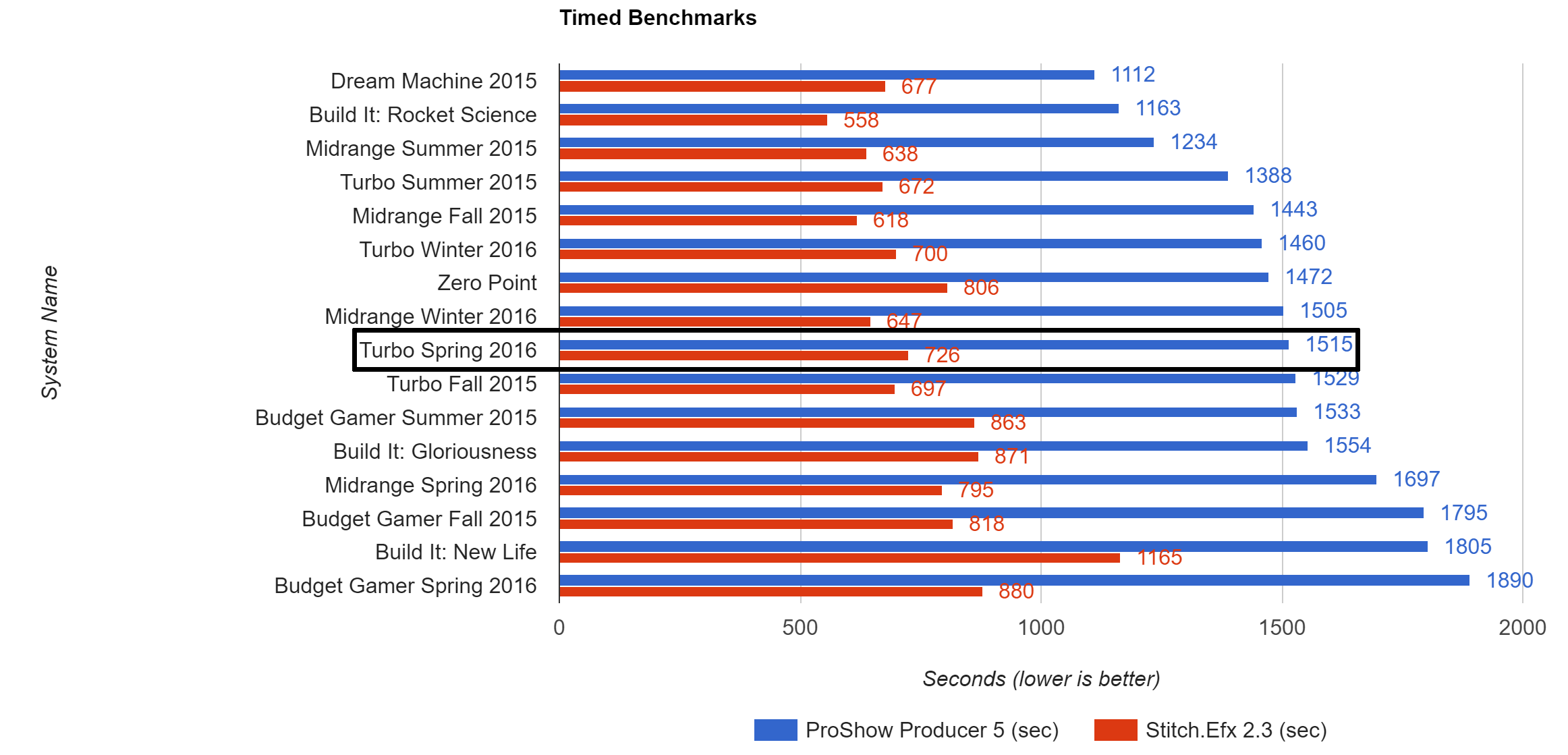
There are enthusiasts of all kinds. Some people collect coins, others travel thousands of miles just to go birdwatching. Some still spend thousands of dollars working on projects cars. For us, PCs are the subject of our enthusiasm. An enthusiast-grade PC evokes something. It’s a point of pride for those who build them. For others, building and tuning an enthusiast PC can be more fun than playing games on them.
Our Blueprints Turbo build is enthusiast grade PC built with 4K gaming in mind. In our quarterly Blueprints series presented by Newegg, there are three price tiers we aim for: $800, $1,500 and $3,000. The Turbo occupied our highest price tier, and aims to deliver performance based on the X99 platform. That means more CPU cores and (usually) a SLI configuration.
While it may come as a shock to some, a budget of $3,000 is still a budget, and there are limitations of where we can go within that constraint. But you won’t see us complaining. Building the Turbo is almost always the most fun of the three PCs (not to mention the fastest to benchmark).
So here’s what we put into this beastly rig:
CPU: Intel Core i7-5820K - $390
GPU: 2x PNY GeForce GTX 980 Ti (reference blower) - $1,280 ($640 ea.)
Mobo: MSI X99A SLI Plus - $200
Keep up to date with the most important stories and the best deals, as picked by the PC Gamer team.
Memory: 32GB (4x8GB) Corsair Vengeance LPX DDR4-2400 (Blue) - $150
SSD: 500GB Samsung 850 Evo M.2 SATA - $156
HDD: 2x 2TB WD Black 7200 RPM 3.5-inch SATA - $245 ($122.50 ea.)
CPU Cooler: Corsair H100i v2 - $105
PSU: 850W SeaSonic X Series X-850 - $140
Case: Phanteks Enthoo Evolv ATX - $180
Total: $2,846
Prices listed for products represent in-cart price (includes instant rebates and excludes tax and mail-in rebates) at time of procurement. Prices are subject to change.
The build
When we’ve started our Turbo builds for the past six months or so, we started off the build by adding the Intel Core i7-5820K to our cart. From there, we usually look for a motherboard and video cards. When it comes to X99 and Haswell-E, there really are only three CPUs to choose from, and the 5820K is the cheapest of the three.
Detractors of the 5820K may say that the CPU is the weakest of the Haswell-E family, pointing out that the CPU only provides 28 PCI express lanes, to the 5930K’s (and the 5960X’s) 40. That may matter when you’re trying to squeeze out every last drop of performance, but for most SLI setups (which stop at two), it won’t matter as much.

Twenty-eight lanes is plenty when you’re only rocking a double SLI setup. The smaller number of lanes does restrict you to PCIe x8 for the second graphics card (as opposed to x16 that the primary card enjoys), but most gamers won’t notice in everyday use. On top of that, the PCIe lane restriction leaves room for an NVMe SSD or other PCIe expansion at PCIe x4. (28 - 16 - 8 = 4.)
Taking all of this into account, we didn’t go with an NVMe drive in this build. Drives like the Samsung 950 Pro are still quite a luxury even at this price bracket. For many users, the extra speed offered by an NVMe SSD won’t be terribly noticeable, and the SATA 850 Evo is still plenty speedy for most uses.
For this build, we went with MSI’s X99A SLI Plus. One of the reasons for this choice (besides its competitive price) is that it supports M.2 in SATA as well as PCIe modes. That’s no small matter; there are plenty of motherboards that only support PCIe over M.2. That’s a recipe for heartache if you’ve chosen an M.2 SSD that uses the SATA bus.
This motherboard is also an ATX board, which can fit nicely into a mid-ATX case. We’ve gone with a micro-ATX before in a Turbo build before, but the ATX board offers a couple more options. First off, it means that we could add in a PCIe SSD later if we chose to. We could even go with three-way SLI, though it would drop all three cards down to x8, and wouldn’t leave any room for any more PCIe devices in terms of PCIe lanes.
Speaking of cases, we went with the sexy Enthoo Evolv ATX from Phanteks. This case is the bigger brother to the $70 Enthoo Evolv iTX, which we used in previous Blueprints Midrange Rig and is currently one of our top picks for mini-ITX cases. The Evolv is well laid-out and felt roomy, even though we mounted our hard drives in the main compartment in full view. The aluminum and steel construction feels sturdy as hell, and the modularity options made installing parts easy. Cable management is a cinch, since the Enthoo has built-in hook-and-loop straps on the backside of the motherboard tray, crossing the cable channel. The PSU compartment helps hide excess cable mess as well.
The Evolv ATX isn’t a cheap case. At $180, the case is pretty high-end as cases go, but we believe that if you’re going to put $2,000 or more into a PC, you owe it to yourself to make sure the exterior looks good. This case definitely accomplishes this goal.
The case is also great for water cooling. Even though we used an all-in-one cooler, there’s plenty of room and mounting holes for pumps and reservoirs that custom-loop systems need. The top radiator bracket slides in and out for easy mounting, and the holes in the bracket are smartly spaced. The holes allow even the thickest radiators to be mounted, since the holes provide clearance for motherboard and memory heatsinks, which can often obstruct proper mounting.
Our choice of GPU was guided by two things: price and thermal performance. Reference blower designs tend to be cheaper than higher-end pre-overclocked graphics cards like the MSI GTX 980 Ti Gaming. The MSI card is one of our top picks, but when you’re looking to buy two cards, it hardly makes any sense to grab a factory overclocked card.
On top of that, thermal dissipation becomes a bigger issue with an SLI setup. Many fan designs tend to spread warm air around the case, which isn’t a big deal with only one card and a good exhaust system in place. But when you add in another card, the first card’s ability to breathe gets impacted, and the second card contributes more heat. Blower designs push all that warm air right out the back of the case, keeping both cards cooler.
Performance
We build the Turbo to be a gaming rig that can take on most games at 4K at high or ultra settings. The blistering power of high-end graphics cards in SLI or Crossfire make this possible.
When we tested this rig, it did indeed perform. And it did quite well considering that both cards were left at stock clock speeds. We noticed that there was enough thermal headroom to do a little lightweight overclocking if we chose to. It’s also worth mentioning that this Turbo used 2,400MHz RAM, while other builds made use of 2,666MHz. That small difference in memory clocks aren’t noticeable in most instances, but it did seem to render slightly different scores across our tests.
When we tested this rig, it did indeed perform. And it did quite well considering that both cards were left at stock clock speeds. We noticed that there was enough thermal headroom to do a little lightweight overclocking if we chose to.

The Turbo had no problems running 3DMark Fire Strike Ultra, but didn’t break the 7,000-point mark. It also did quite well in our game benchmarks, making mincemeat out of Batman: Arkham City with a total of 202 FPS. Both of our 4K tests, Middle Earth: Shadow of Mordor and 2013’s Tomb Raider topped 70 FPS, which is awesome.
We consider anything over 60 FPS at 4K more than enough for a few reasons. First of all, there are precious few 4K monitors equipped with G-Sync. Secondly, and probably most importantly, there’s nearly every video card and monitor out there can only take DisplayPort 1.2 at best. DisplayPort 1.2’s throughput only allows 4K up to 60Hz. While this will change as manufacturers adopt DisplayPort 1.4, there isn’t much choice if you want to play games at 4K/60Hz, let alone anything higher. That means if you’re pushing 4K over 60 FPS, you won’t see those extra frames for the time being.

When it comes to the timed benchmarks, the 5820K’s extra cores didn’t always help this rig out. While the Turbo did reasonably well, midrange rigs with i7-6700K Skylake and i7-4790K Devil’s Canyon parts outpaced the lower-clocked Haswell-E. The bright side to this is that the 5820K can overclock quite well. Our PSU doesn’t offer a whole lot of headroom for overclocking, but a moderate overclock will keep this system in the green and improve single-core performance some.

Where the 5820K shines is in multithreaded applications. In our x264 video encoding test, it’s all about the cores. The hexa-core 5820K offers up 12 logical cores after hyperthreading is factored in, which gives x264 a lot to play with. When compared with the midrange rigs, the Turbo rigs tend to pull way out in front in multithreaded applications.

The downside to this is that not a whole lot of people use applications that make the most of a CPU with more than four cores. That’s not a huge deal, and if you are planning on doing any music or video editing or production, the extra cores of Haswell-E will serve you well. While there are more powerful chips out there, the 5820K represents the cheapest current-generation Haswell-E part you can get. The next step up is the Core i7-5930K which runs about $580. If you want to go higher, the i7-5960X offers eight cores for a cool $1,017. And that’s cheap compared to 10 or 12-core Xeon parts.
Our Turbo build has been the happy home of many a Haswell-E chip, but that may soon change with the anticipated release of Broadwell-E. As time marches on, so does the tech, and this will likely be the last time we spec out a Haswell-E build. But that doesn’t mean you shouldn’t. Haswell-E is a solid platform, and Broadwell-E will (likely) push prices of Haswell-E chips down. For those who want an enthusiast-grade rig for work or play, the dawn of Broadwell-E will be a good thing for both budget-minded builders and riders of the bleeding edge alike.
A note on affiliates: some of our stories, like this one, include affiliate links to online stores. These online stores share a small amount of revenue with us if you buy something through one of these links, which help support our work evaluating components and games.
PC Gamer is the global authority on PC games—starting in 1993 with the magazine, and then in 2010 with this website you're currently reading. We have writers across the US, Canada, UK and Australia, who you can read about here.


